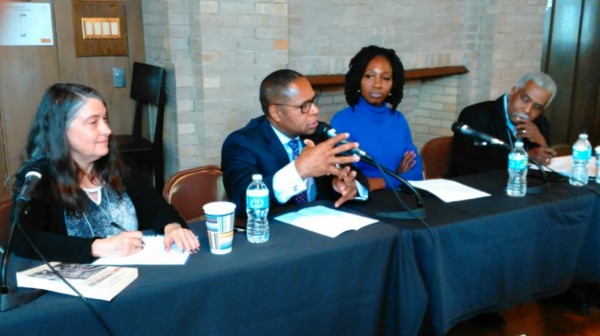Economic disinvestment on Chicago’s West Side has been fueled by decades of neglect and bad public policies by city government, community activists and social service experts said Thursday at a event hosted by the Jane Addams-Hull House Museum.
Revitalizing West Side neighborhoods was the theme for the all-day workshop held May 19, the first event of a year-long project the museum is undertaking on the topic.
The North and South sides, as well as Downtown, has seen millions of dollars spent on development projects, while the West Side has received hardly any spending, panelists said.
“The notion that a community area is not worthy of investment is an unacceptable premise,” said Amara Enyia, executive director of the Austin Chamber of Commerce.
Enyia said she saw disinvestment practices first hand during her stint as a young staffer in Mayor Richard M. Daley’s administration in the late 2000s.
“We never talked about the West Side. It rarely came up in any conversations, and that stood out to me,” said Enyia, who left the mayor’s office after a couple of years.
That neglect has continued, she said.
The city, she noted, is offering billions of dollars to build the Lucas Museum on the lake front Downtown while CPS closes schools on the West Side.
Chicago, meanwhile, is also able to come up with millions of dollars to settle police misconduct cases rather than invest in neighborhoods, said panelist Rufus Williams, CEO of BBF Family Services and a former president of the Chicago Board of Education.
Chicago has paid out half a billion dollars in settlements over a 10-year period, largely to families whose relatives were shot by police officers. One of the most recent, $5 million, went to Laquan McDonald’s family for his October 2014 shooting death by Officer Jason Van Dyke, who faces murder charges in the case.
“We’ve paid $500 million for police misconduct, yet we can’t get the investment we need for our schools,” Williams said. “We find the money when we need it, we just don’t find it for the right things.”
West Side disinvestment was also spurred when companies like Sears, Zenith and Western Electric left the area for the suburbs in the 1970s and 1980s.
Racist public policies has been a primary driver of West Side disinvestment, said Beryl Satter, a history professor at Rutgers University and author of Family Properties: Race, Real Estate and the Exploitation of Black Urban America.
Her 2009 book examines housing abuses from the 1940s through 1970s in Chicago.
It’s also part family diary, as she wrote about her Jewish parents who lived in Garfield Park in the 1930s. Her father, Mark Satter, was a West Side property owner and lawyer who represented black residents victimized in racist housing scams in the 1950s and early 1960s.
From then to the present, predatory lending and other real estate scheming has kept the West Side overcrowded and financially depressed, Satter said.
Black families were victimized by real estate agents who would sell them homes at two to four times their original value. Discriminatory housing practices by banks also made it virtually impossible for blacks to get a home mortgage.
As a result, blacks wanting to own their own homes had to settle for shady contract payment plans to agents; if they missed just one payment, they could lose their home and the money they had already invested in the property.
The city, Satter said, turned a blind eye to the problem.
To this day, this history is either glossed over or ignored, Satter said. Instead, black residents tend to get the lion’s share of the blame for the conditions they live in, she said.
“There became this discourse that black people just didn’t know how to maintain their properties, and that’s why the West Side is in the condition it’s in. Just all these lies. It was just a vicious blaming of the victims.”
The Jane Addams-Hull House Museum’s year-long project is funded through a grant from the National Endowment for the Humanities.
“This is a part of our history we should talk about it,” said Jennifer Scott, the museum’s director. “We wrote the grant to try to put the histories of neighborhoods on the West Side into the conversation about neighborhood change.”
Scott, who became director last year, said there’s not much documented history of the West Side, which was another thought behind launching the project. More community workshops will take place over the summer at partnering sites, including the National Hellenic Museum in Greek Town and Frederick Douglass Public Library in North Lawndale.
“This was the kick-off event to tease out all these issues of racism and disinvestment, urban renewal and interventions,” Scott said. “These are huge issues across all neighborhood.”
